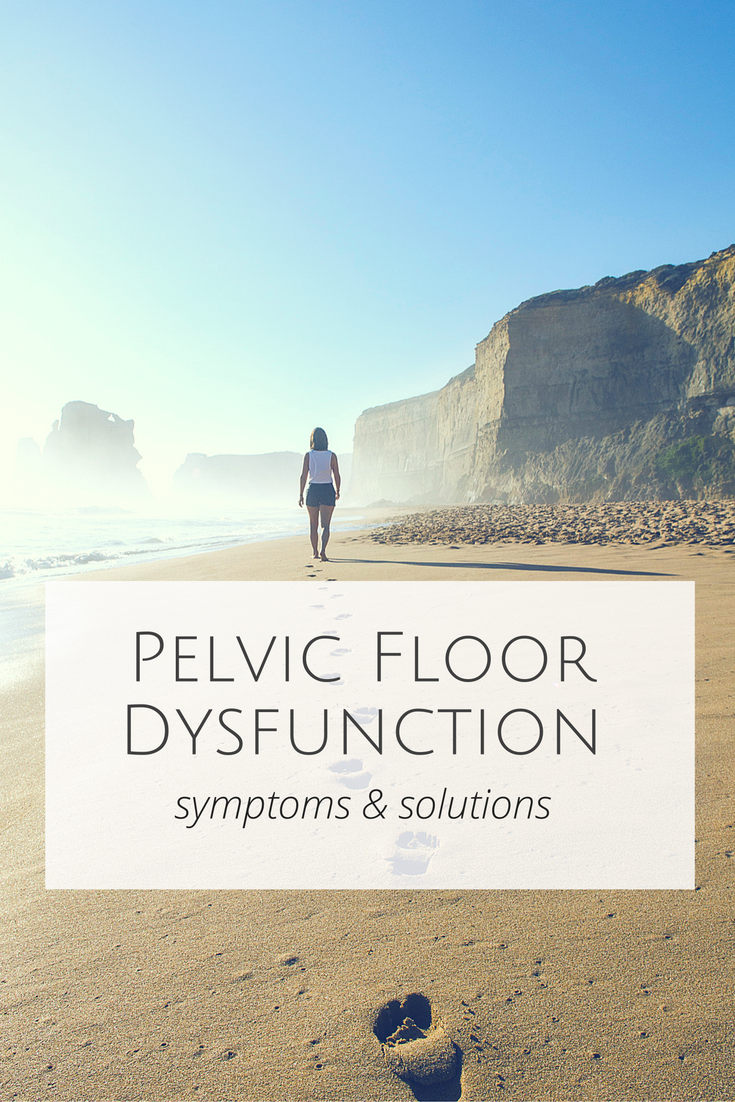
Blog
What is Pelvic Floor Dysfunction and could you have it?
Hi Beauties,
We’re tackling a really important topic in today’s post: Pelvic Floor Dysfunction. It’s a topic that many don’t talk about because of shame, fear or embarrassment. But it’s a common condition that needs to be brought to light.
A member of The Balanced Life Sisterhood recently shared a her experience with Pelvic Floor Dysfunction after YEARS of silence and suffering alone. She shared her story in an effort to help others and to her surprise, she received comments and messages from other women who had been silently suffering, thanking her for being brave and sharing her story.
Here’s what she said…
As August comes to a close, and I am getting ready to celebrate my six month “Balanced Life-iversary”, as I like to call it. 🙂 I thought I would finally share my own personal non-scale victory. I have tried writing this post a few times in previous months, but always ended up deleting it, as this is a pretty personal, and somewhat embarrassing topic for me. But oh well, I deserve to celebrate ALL of my successes since finding Robin on March 1st! Well sisters, here goes nothing…
It all started about ten years ago and I would wake up at night with the most severe cramping ever. I equate the pain to labor pains or worse, that’s how bad it was. But the reason the cramping is embarrassing is that it was in my bottom, yes, of all places, this horrible horrible pain was coming from my rectum, or so I thought. After months of enduring this several times per month, night/day, didn’t matter, my husband made me go to the doctor. “The DOCTOR, are you serious honey, what on earth am I going to tell him, that this butt pain is so extremely terrible that it’s waking me at night??!! He’ll look at me and tell me I’m nuts!” And actually that’s how I felt, I literally thought I was going crazy. I mean, who on earth has butt cramps??
So long story short (ok maybe not that short) I went for my appointment, and guess what, it actually IS a real thing, it’s called Pelvic Floor Dysfunction. And I learned that it wasn’t ever my rectum, it was all the muscles surrounding my rectum causing the excruciating pain.
I’ve been on steroid creams, medications, and physical therapy. Unfortunately, the PT only lasted so long, and the episodes, as I called them, continued to get so bad that I ended up in the ER because I passed out from the pain. Sisters, at my worst, I was having these episodes 2-3 times per week. I thought I was going to lose it, it was hard for me to care for myself and my family.
THEN……DRUM ROLL PLEASE……a friend posted about Robin’s 30 Day Challenge!!
I started doing Pilates for the first time in my life. I fell in love with Robin and the workouts from the very start!
I’m so proud to say that I’ve pretty much completed at least twenty minutes every day since. And guess what…the best part is that in March…6 cramps, April…4 cramps, May …4 cramps, June…3 cramps, July…ONLY 2, and AUGUST….I HAVEN’T HAD ONE!!!!
Sisters, it’s been TEN years of this! I haven’t gone a month without a cramp for TEN YEARS!
I really think God knew Robin’s workouts were exactly what I needed to heal. As much as she has us work our pelvic floor area, I just KNOW that this is the reason I’m so much better!!
Yes, Pilates has helped me get stronger and actually see muscles that I never have seen on my body before, but the real reason I’ll never leave The Balanced Life is because of the pain it has taken away for me.
So yes, Pelvic Floor Dysfunction is a REAL thing, and only those who have suffered from it will truly know what I mean. Also, please pass this along if you know anyone who may be suffering in silence like I did. Robin, you truly ARE an answered prayer for me, and for this I will always be grateful to you!!
How powerful is this?
It’s times like these that I am so grateful for the internet and the way we can connect with people all over the world for support, guidance and healing.
After reading this post (and the comments that followed), I realized that I need to address this here on the blog to help women who may not know what is going on “down there”.
An Interview with Physical Therapist, Mandie Aaker Martin
I’m honored to have my colleague and friend, Mandie, here to share more information on Pelvic Floor Dysfunction (PFD) and what steps you can take to begin the healing process. Mandie is one of the best physical therapists I know and has an incredible understanding of the body and how it works. So let’s dive in..
What is Pelvic Floor Dysfunction and what causes it?
Pelvic Floor Dysfunction is a wide range of problems associated with the control of the pelvic floor muscles. Pelvic floor muscles can be too tight or weak. Individuals with PFD can also have Sacroiliac, pelvis, or hip problems impacting the function of their pelvic floor musculature. Individuals with PFD tend to keep the pelvic floor muscles in a contracted, shortened state rather than a lengthened, supported state.
Pelvic floor dysfunction can be caused by a variety of factors. In women, the primary cause is often related to pregnancy or child birth. Other causes include infections, poor posture, chronic back or SI joint pain, trauma, surgery, or nerve dysfunction. Sometimes the cause is unknown.
When you see clients with PFD what are the typical symptoms?
Symptoms include the following:
- Unexplained pain in the low back, pelvis, genitals, or rectum
- Urinary frequency or difficulty urinating
- Constipation, straining, and/or pain with bowel movements
- Sensation of heaviness or fullness in the pelvic floor region
- Painful intercourse for women
If someone is experiencing PFD, what can they do to correct or improve their situation?
Pelvic Floor Dysfunction symptoms can be embarrassing to talk about; however, the treatments and interventions can be very successful. Options for correcting or improving pelvic floor function can include the following:
- Physical therapy including biofeedback, education on behavioral changed including how to go to the bathroom, what foods might be affecting the PFD, manual therapy, and guided core/pelvic floor, body mechanics, and postural reeducation for improved pelvic floor function.
- Medical interventions including medications, injections, and possibly surgery.
- Pilates or yoga to teach the pelvic floor muscles to be supportive in a shortened/contracted position as well as a lengthened supportive position. Gently strengthening and reeducating the rest of the core, improving posture, and body mechanics.
Are there any exercises or activities that should be avoided for those with PFD?
Depending on the intensity of PFD, there will potentially be exercises or activities one would want to avoid or modify. If he/she must strain excessively to complete an exercise, it increases pressure on the pelvic floor. This can overload an already stressed pelvic floor. As an individual improves his/her pelvic floor control, the intensity of exercise can increase.
Potential Pilates specific exercises to be modified or avoided include:
- Full Planks (modifications could include planks on the knees, reducing the duration of the plank, or kneeling pushups).
- Chest lifts or sit-up, especially a sustained chest lift (modification options could include putting the legs onto an ottoman, reducing range, or opting for something like a bridge or lower body core exercise, keep head down or supported in small chest lift position)
- Hundreds (alter leg position to table top or supported on an ottoman or couch, keep head down but continue arm pumps)
- Scissors or exercises where you lower both legs (modify by reducing range, keep legs at the top of the range)
- Pushups (perform on knees, complete fewer repetitions)
Remember, as with all exercise, please seek medical help if you have any concerns. These medical professionals can direct you safely regarding your specific diagnosis. Specifically guided instruction can get you started on your path to healing.
Thank you so much, Mandie! If you’re reading this and realizing that you may be dealing with some level of PFD, I encourage you to seek professional help. It’s nothing to be ashamed of, it’s more common than you think and there IS hope.
xo,
About the PT: Mandie Aaker Martin completed her doctoral degree in physical therapy 2004 and Rehabilitation Pilates certification in 2006. She sees physical therapy patients and teaches Pilates and CoreAlign with the intention of improving her clients’ overall well-being, posture, body mechanics, balance, coordination, and function for their daily life and activities.
share this post
Helping You Break Free!
Get your weekly delivery of inspiration—Pilates, nourishment,
& mindfulness—changing your relationship with food and your body.









7 thoughts on “What is Pelvic Floor Dysfunction and could you have it?”
I’m glad to see a post about this. I suffered from it for about 10 years and received manual therapy, physical therapy, medications, biofeedback, and didn’t find relief from those things immediately. Honestly, I didn’t find relief until after my first pregnancy. I saw numerous doctors including two gynecologists, a urologist, and a gastroenterologist. The urologist recommended that I have botox injections to freeze the muscles and prevent spasms, however the side effects could last 6 months and would have possibly included leakage from unwanted places…. the other option he told me was to get pregnant, which would help stretch the muscles out from being so tight constantly. I decided to do that, and although the sex was SOOOO painful, I did conceive and delivered a healthy baby boy via c-section. I believe that God healed me from this, and am thankful for being healed from the pain that I suffered. I am now free of the pain I suffered for all of those years.
Wow, thank you so much for sharing! I am so happy you finally found relief! xoxo
In IC patients, PFD is usually related to the presence of too much tension (or high-tone), the opposite of the too-relaxed state (or low-tone) that contributes to incontinence. However, sometimes IC patients with PFD can have a combination of muscles that are too tense and too relaxed. – See more at: http://www.ichelp.org/about-ic/associated-conditions/pelvic-floor-dysfunction/#sthash.jqgxC5EA.dpuf
Hi, thanks for sharing your story. And of course, PFD is a worse condition which is faced by many people commonly. Your article is helpful and beneficial especially your exercising tips.
This article is such a blessing; thanks Robin for posting.
I had a hysterectomy 2 years ago for Endometriosis and Fibroid Tumors. However I still suffer with excruciating pelvic floor and bladder pain from possible intersistial cystitis which is hereditary and often goes along with Endometriosis, etc. I just joined the Sisterhood recently and already the Pilates workouts are helping me to manage my chronic spinal pain, but now I feel hopeful again after reading this article/story for the pelvic pain as well. Many thanks to you and the sweet woman who shared her story. God bless you ladies!
Can you possibly tell me what Pilates program you would recommend for someone with possible pelvic floor dysfunction? This was so encouraging to read! I have had unexplained tailbone pain when sitting for about 6 months and my chiropractor thinks this is what I am dealing with. Thank you for any help. 🙂
Hi Jessica! Thanks for your comment. 🙂 Consistent Pilates for someone with PFD is recommended! If you’re familiar with Pilates, try our online programs – just make sure to follow the modifications listed above. If you’re new to Pilates, it may be worth it to go to a studio with a trained instructor to learn what modifications are safe and recommend for you. And as walls, check with your medical provider to see if Pilates is recommend for you. I hope this helps! 🙂